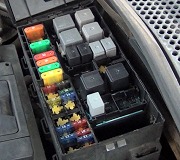A simple trick to finding a short is to replace the blown fuse with a pair of spade terminals, then use small jumper wires to connect them to a 12 volt light bulb. A brake light bulb works well. When the circuit is live and the short is present, the bulb will be full brightness and hot so be sure it's not laying on the carpet or against a plastic door panel. Now you can unplug electrical connectors and move things around to see what makes the short go away. When it does, the bulb will get dim or go out.
That's my standard reply for blowing fuses. It is likely you have an additional variable in that the Engine Computer only turns on the automatic shutdown, (ASD) relay for one second after you turn on the ignition switch, then again any time there's engine rotation, (cranking or running). That kind of limits how much time you get to troubleshoot the problem. In this case, remove the ASD relay, then see if a new fuse blows. If it does not, that relay feeds the alternator field, ignition coil(s), injectors, fuel pump or pump relay, and the oxygen sensor heaters. Of all of those things, the only thing that I've heard of before is a wiring harness going to the oxygen sensors falls down onto hot exhaust parts. Once the wires melt, there will be a short to ground on that circuit.
Another clue is if that fuse blows as soon as you turn on the ignition switch, leave it on, then replace the fuse with the engine obviously not running. If the new fuse doesn't blow until you turn the ignition switch off and back on, that's the circuit you're dealing with.
Sunday, June 15th, 2014 AT 9:30 PM



